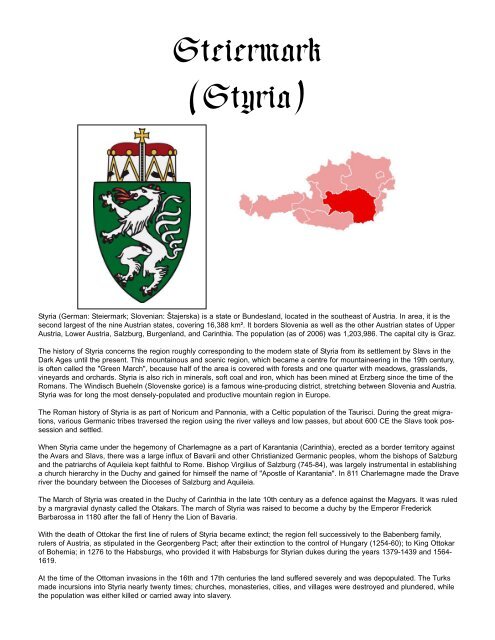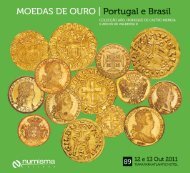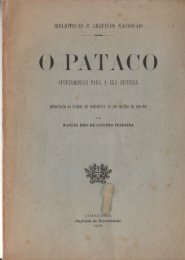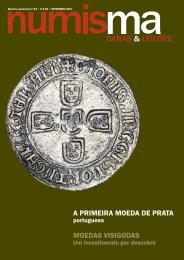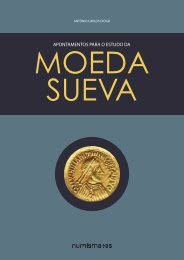Silver Pfennigs and Small Silver Coins of Europe in the Middle Ages
Silver Pfennigs and Small Silver Coins of Europe in the Middle Ages
Silver Pfennigs and Small Silver Coins of Europe in the Middle Ages
You also want an ePaper? Increase the reach of your titles
YUMPU automatically turns print PDFs into web optimized ePapers that Google loves.
Steiermark<br />
(Styria)<br />
Styria (German: Steiermark; Slovenian: Štajerska) is a state or Bundesl<strong>and</strong>, located <strong>in</strong> <strong>the</strong> sou<strong>the</strong>ast <strong>of</strong> Austria. In area, it is <strong>the</strong><br />
second largest <strong>of</strong> <strong>the</strong> n<strong>in</strong>e Austrian states, cover<strong>in</strong>g 16,388 km². It borders Slovenia as well as <strong>the</strong> o<strong>the</strong>r Austrian states <strong>of</strong> Upper<br />
Austria, Lower Austria, Salzburg, Burgenl<strong>and</strong>, <strong>and</strong> Car<strong>in</strong>thia. The population (as <strong>of</strong> 2006) was 1,203,986. The capital city is Graz.<br />
The history <strong>of</strong> Styria concerns <strong>the</strong> region roughly correspond<strong>in</strong>g to <strong>the</strong> modern state <strong>of</strong> Styria from its settlement by Slavs <strong>in</strong> <strong>the</strong><br />
Dark <strong>Ages</strong> until <strong>the</strong> present. This mounta<strong>in</strong>ous <strong>and</strong> scenic region, which became a centre for mounta<strong>in</strong>eer<strong>in</strong>g <strong>in</strong> <strong>the</strong> 19th century,<br />
is <strong>of</strong>ten called <strong>the</strong> "Green March", because half <strong>of</strong> <strong>the</strong> area is covered with forests <strong>and</strong> one quarter with meadows, grassl<strong>and</strong>s,<br />
v<strong>in</strong>eyards <strong>and</strong> orchards. Styria is also rich <strong>in</strong> m<strong>in</strong>erals, s<strong>of</strong>t coal <strong>and</strong> iron, which has been m<strong>in</strong>ed at Erzberg s<strong>in</strong>ce <strong>the</strong> time <strong>of</strong> <strong>the</strong><br />
Romans. The W<strong>in</strong>disch Bueheln (Slovenske gorice) is a famous w<strong>in</strong>e-produc<strong>in</strong>g district, stretch<strong>in</strong>g between Slovenia <strong>and</strong> Austria.<br />
Styria was for long <strong>the</strong> most densely-populated <strong>and</strong> productive mounta<strong>in</strong> region <strong>in</strong> <strong>Europe</strong>.<br />
The Roman history <strong>of</strong> Styria is as part <strong>of</strong> Noricum <strong>and</strong> Pannonia, with a Celtic population <strong>of</strong> <strong>the</strong> Taurisci. Dur<strong>in</strong>g <strong>the</strong> great migrations,<br />
various Germanic tribes traversed <strong>the</strong> region us<strong>in</strong>g <strong>the</strong> river valleys <strong>and</strong> low passes, but about 600 CE <strong>the</strong> Slavs took possession<br />
<strong>and</strong> settled.<br />
When Styria came under <strong>the</strong> hegemony <strong>of</strong> Charlemagne as a part <strong>of</strong> Karantania (Car<strong>in</strong>thia), erected as a border territory aga<strong>in</strong>st<br />
<strong>the</strong> Avars <strong>and</strong> Slavs, <strong>the</strong>re was a large <strong>in</strong>flux <strong>of</strong> Bavarii <strong>and</strong> o<strong>the</strong>r Christianized Germanic peoples, whom <strong>the</strong> bishops <strong>of</strong> Salzburg<br />
<strong>and</strong> <strong>the</strong> patriarchs <strong>of</strong> Aquileia kept faithful to Rome. Bishop Virgilius <strong>of</strong> Salzburg (745-84), was largely <strong>in</strong>strumental <strong>in</strong> establish<strong>in</strong>g<br />
a church hierarchy <strong>in</strong> <strong>the</strong> Duchy <strong>and</strong> ga<strong>in</strong>ed for himself <strong>the</strong> name <strong>of</strong> "Apostle <strong>of</strong> Karantania". In 811 Charlemagne made <strong>the</strong> Drave<br />
river <strong>the</strong> boundary between <strong>the</strong> Dioceses <strong>of</strong> Salzburg <strong>and</strong> Aquileia.<br />
The March <strong>of</strong> Styria was created <strong>in</strong> <strong>the</strong> Duchy <strong>of</strong> Car<strong>in</strong>thia <strong>in</strong> <strong>the</strong> late 10th century as a defence aga<strong>in</strong>st <strong>the</strong> Magyars. It was ruled<br />
by a margravial dynasty called <strong>the</strong> Otakars. The march <strong>of</strong> Styria was raised to become a duchy by <strong>the</strong> Emperor Frederick<br />
Barbarossa <strong>in</strong> 1180 after <strong>the</strong> fall <strong>of</strong> Henry <strong>the</strong> Lion <strong>of</strong> Bavaria.<br />
With <strong>the</strong> death <strong>of</strong> Ottokar <strong>the</strong> first l<strong>in</strong>e <strong>of</strong> rulers <strong>of</strong> Styria became ext<strong>in</strong>ct; <strong>the</strong> region fell successively to <strong>the</strong> Babenberg family,<br />
rulers <strong>of</strong> Austria, as stipulated <strong>in</strong> <strong>the</strong> Georgenberg Pact; after <strong>the</strong>ir ext<strong>in</strong>ction to <strong>the</strong> control <strong>of</strong> Hungary (1254-60); to K<strong>in</strong>g Ottokar<br />
<strong>of</strong> Bohemia; <strong>in</strong> 1276 to <strong>the</strong> Habsburgs, who provided it with Habsburgs for Styrian dukes dur<strong>in</strong>g <strong>the</strong> years 1379-1439 <strong>and</strong> 1564-<br />
1619.<br />
At <strong>the</strong> time <strong>of</strong> <strong>the</strong> Ottoman <strong>in</strong>vasions <strong>in</strong> <strong>the</strong> 16th <strong>and</strong> 17th centuries <strong>the</strong> l<strong>and</strong> suffered severely <strong>and</strong> was depopulated. The Turks<br />
made <strong>in</strong>cursions <strong>in</strong>to Styria nearly twenty times; churches, monasteries, cities, <strong>and</strong> villages were destroyed <strong>and</strong> plundered, while<br />
<strong>the</strong> population was ei<strong>the</strong>r killed or carried away <strong>in</strong>to slavery.


